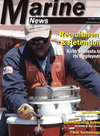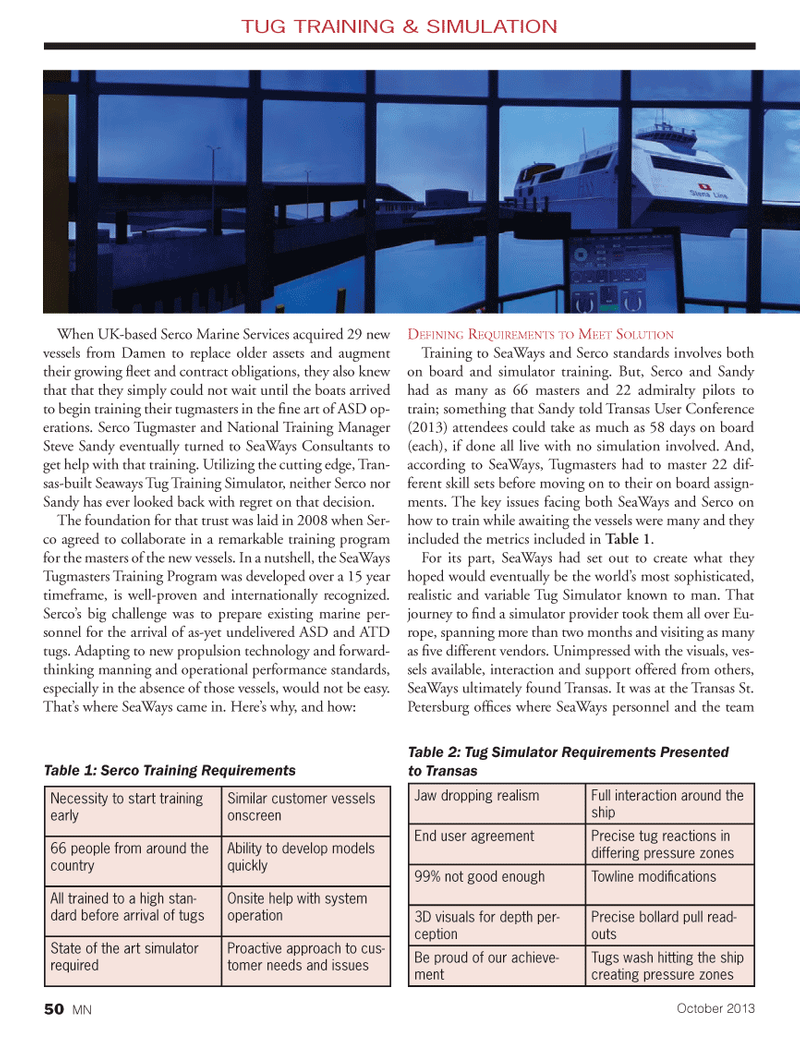
Page 50: of Marine News Magazine (October 2013)
Manning: Recruitment & Retention
Read this page in Pdf, Flash or Html5 edition of October 2013 Marine News Magazine
When UK-based Serco Marine Services acquired 29 new vessels from Damen to replace older assets and augment their growing ß eet and contract obligations, they also knew that that they simply could not wait until the boats arrived to begin training their tugmasters in the Þ ne art of ASD op- erations. Serco Tugmaster and National Training Manager Steve Sandy eventually turned to SeaWays Consultants to get help with that training. Utilizing the cutting edge, Tran- sas-built Seaways Tug Training Simulator, neither Serco nor Sandy has ever looked back with regret on that decision. The foundation for that trust was laid in 2008 when Ser- co agreed to collaborate in a remarkable training program for the masters of the new vessels. In a nutshell, the SeaWays Tugmasters Training Program was developed over a 15 year timeframe, is well-proven and internationally recognized. SercoÕs big challenge was to prepare existing marine per- sonnel for the arrival of as-yet undelivered ASD and ATD tugs. Adapting to new propulsion technology and forward- thinking manning and operational performance standards, especially in the absence of those vessels, would not be easy. ThatÕs where SeaWays came in. HereÕs why, and how: DEFINING REQUIREMENTS TO MEET SOLUTION Training to SeaWays and Serco standards involves both on board and simulator training. But, Serco and Sandy had as many as 66 masters and 22 admiralty pilots to train; something that Sandy told Transas User Conference (2013) attendees could take as much as 58 days on board (each), if done all live with no simulation involved. And, according to SeaWays, Tugmasters had to master 22 dif- ferent skill sets before moving on to their on board assign- ments. The key issues facing both SeaWays and Serco on how to train while awaiting the vessels were many and they included the metrics included in Table 1 .For its part, SeaWays had set out to create what they hoped would eventually be the worldÕs most sophisticated, realistic and variable Tug Simulator known to man. That journey to Þ nd a simulator provider took them all over Eu- rope, spanning more than two months and visiting as many as Þ ve different vendors. Unimpressed with the visuals, ves- sels available, interaction and support offered from others, SeaWays ultimately found Transas. It was at the Transas St. Petersburg ofÞ ces where SeaWays personnel and the team TUG TRAINING & SIMULATION Necessity to start training early Similar customer vessels onscreen 66 people from around the country Ability to develop models quickly All trained to a high stan-dard before arrival of tugs Onsite help with system operation State of the art simulator required Proactive approach to cus- tomer needs and issues Jaw dropping realism Full interaction around the ship End user agreement Precise tug reactions in differing pressure zones 99% not good enough Towline modiÞ cations 3D visuals for depth per-ception Precise bollard pull read- outs Be proud of our achieve- ment Tugs wash hitting the ship creating pressure zones Table 1: Serco Training Requirements Table 2: Tug Simulator Requirements Presented to Transas October 201350 MNMN October2013 Layout 50-58.indd 50MN October2013 Layout 50-58.indd 509/30/2013 11:38:53 AM9/30/2013 11:38:53 AM

 49
49

 51
51
